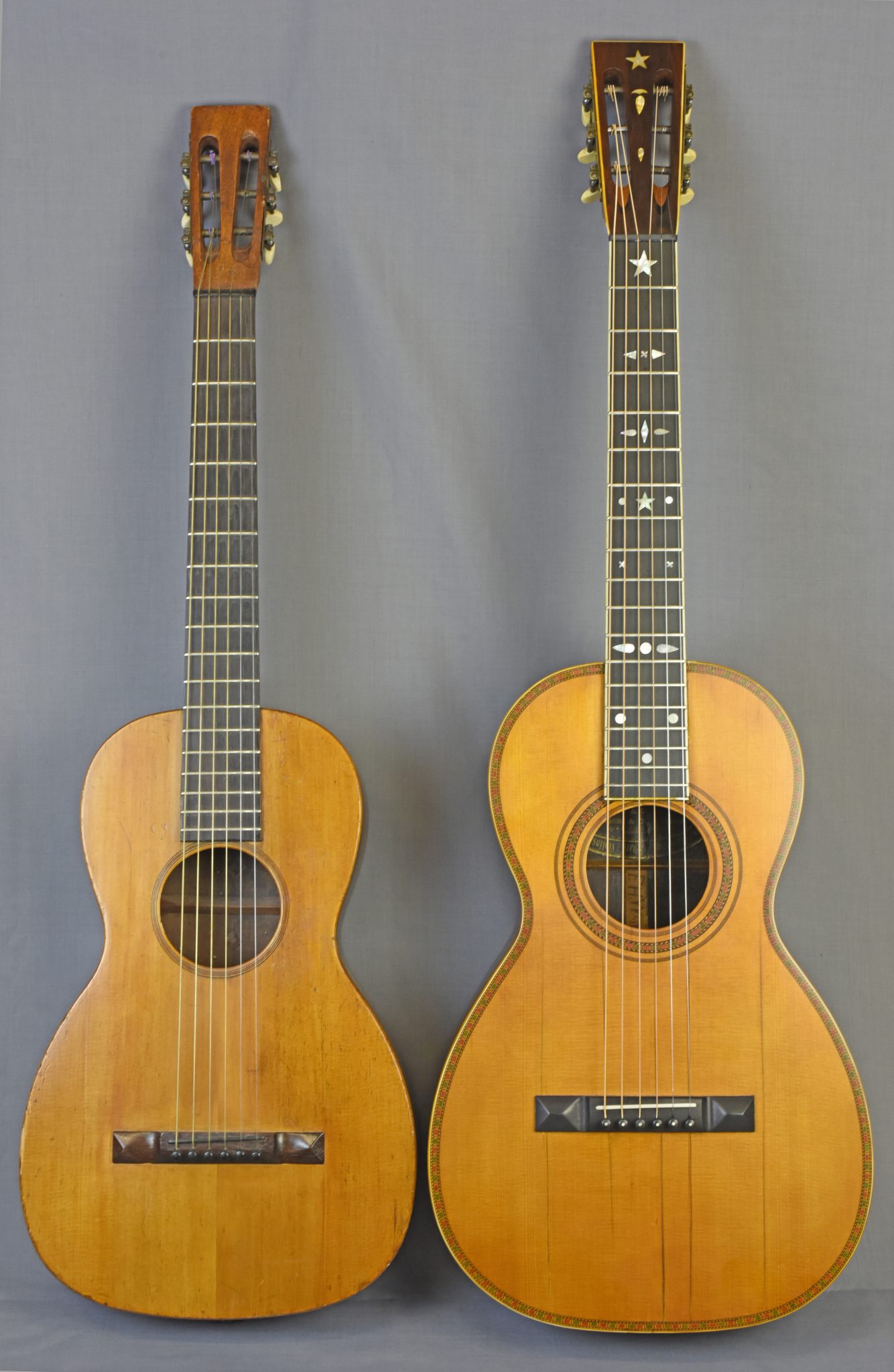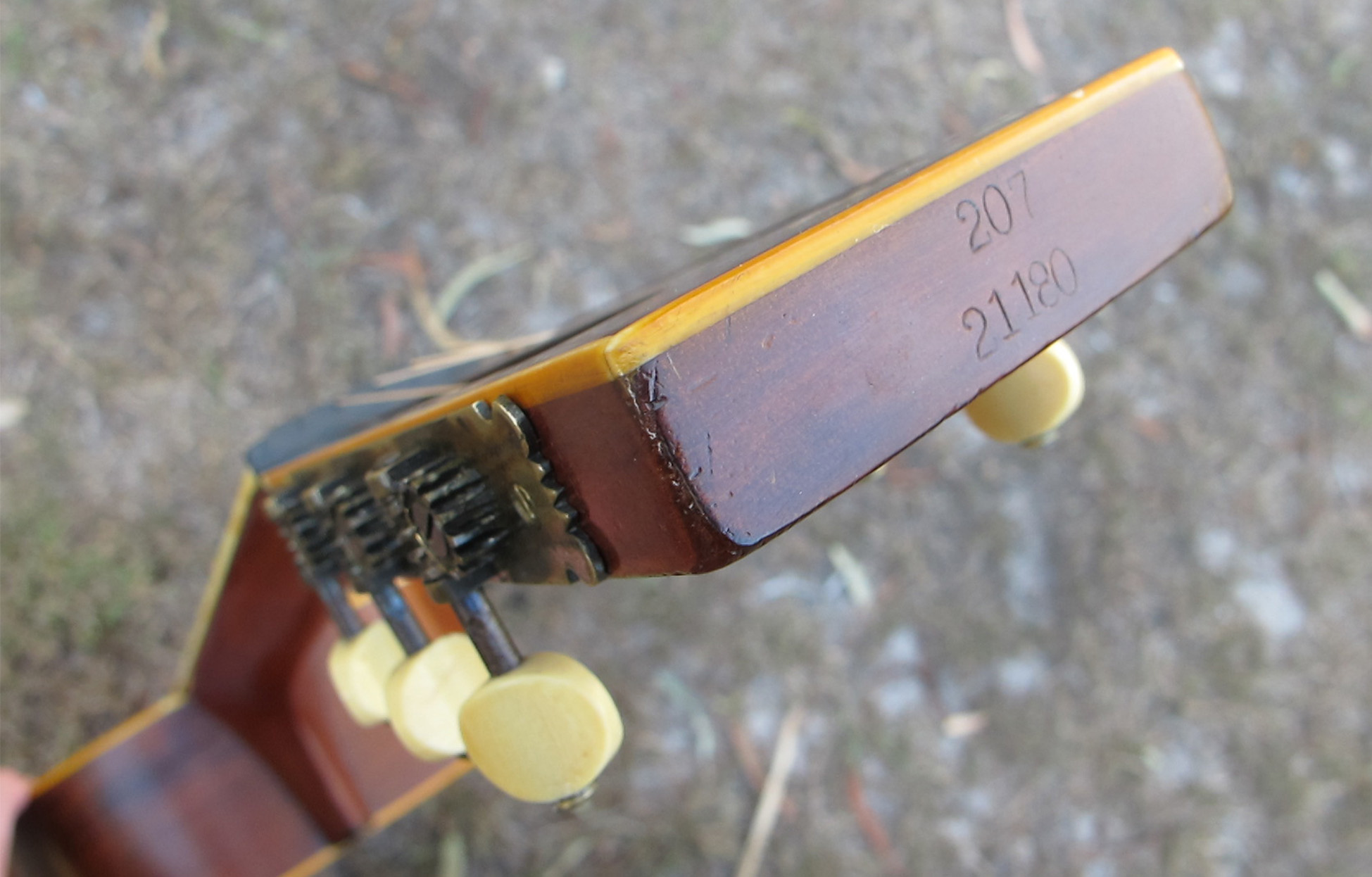A hundred and twenty-year-old guitar that is an impressive survivor of an era before electricity.
The vintage Bay State guitars were made from about 1887 to 1904 by the John C. Haynes Company in Boston. If you want to know more about the history of Bay State Guitars and the different models and dating of the serial numbers, check out the links to the two pages I have made in conjunction with luthier Sylvan Wells, who owns the Bay State Guitar name:
HISTORY: The John C. Haynes Company and vintage Bay State guitars,
MODELS & DATING: Vintage Bay State guitars.
I also urge you to register your Bay State Guitar by emailing me the instrument details to the address on that page.

I have to thank Elaine and Larry for selling me this guitar and having faith that I would restore it and do it justice. It has been a long road in getting it restored, more than 6 years in fact! But I eventually got there.
What kept holding me up was trying to work out a way I could minimize the prominence of the splits on the top of the guitar. In the end I decided I had to accept them, as they are part of the guitar’s history.
The guitar on the right is the Style 207 Bay State and it is CONCERT size. In the 1800’s the standard guitar size for domestic use was quite small, made to play in the parlor of the home, which is where the term ‘parlor guitar’ originates. Here the Style 207 is placed beside a standard sized Bay State guitar guitar of the era.

Without electricity, makers realized that bigger guitars with more projection were needed for public performances. So various sizes were added; for example, the Style 207 is the Concert size of the Standard sized 206. There was also a Large Concert size and an Extra Large Concert size (the 208). The Two-Thirds sized guitar, listed in the above catalogue page is a Terz guitar, equivalent of today’s half-sized guitar.
From the webpage I listed previously I have had people write in to help me date these guitars from their serial numbers. From the more than 170 Bay State guitars I have registered these larger sized Bay States are quite rare. Totaling all the styles, the first table shows the numbers of the different guitar sizes I have registered:

The table on the right shows the comparative dimensions of the Concert size against the standard sized Bay State.
And this Style 207 Bay State is only the second I have registered. With a serial number of 21180 it dates between 1895 and 1900.
 The Style and Serial number was stamped into the top of the headstock of almost all vintage Bay State guitars.
The Style and Serial number was stamped into the top of the headstock of almost all vintage Bay State guitars.

It looks like a previous owner (F.H. White) has written their name inside the guitar.
Description of Style 207 from the c.1895 catalogue:
Rosewood. Elegant inlay around sound hole and front edge [love the red and green combination, which is different than the other 207 model that has surfaced]. Rich inlaid stripe down back and across side under end pin. Top and back corners inlaid with Celluloid. Mahogany neck, convex Ebony fingerboard bound with Celluloid and inlaid with Pearl. Ivory nut and bridge saddle [both missing, replaced with Tusq]. Head veneered with Rosewood and bound with Celluloid. Elegantly French polished. [Cost at the time $66.00, equivalent in 2019 to $2.022].
WORK DONE on this guitar:
- Splits cleated and glued
- Neck Reset
- Re-Fret
- New Bridge (see detail of its construction here)
- Damaged mother-of-pearl pieces in the fret-board replaced
- Replacement tuners from a similar aged Bay State guitar
- Head-stock repair
- All bracing re-glued
A couple of youtube posts with my friend Mali playing this restored guitar in the first clip, and my grandson, Sid, playing in the second::
Yes, and that’s thunder you can hear in the first clip!
Namaste and thanks for following. Charles















I always enjoy the unexpected arrival of your vintage guitar posts. My Bruno and Son parlor also has a serial number stamped similarly on it’s headstock but as that number differs from the number inside the body I believe that the number on the headstock might be an inventory number as the Bruno company was a distributor of musical instruments and not a manufacturer. Still have not been able to identify the model or date it. Maybe one of your readers can point me in the right direction. My research has only lead me to dead ends.
Great job on the restoration of this lovely Bay State.
Hope you are well.
All best. Great love.
Hi Alfredo, Yes information on the Bruno company is hard to find. I remember years ago I read somewhere that they started as a manufacturer but soon became a ‘jobber’, i.e. reselling guitars instruments made to their requirements by other makers. But not sure if that was correct. I too would be interested if anyone can help shine some light on this company. If I receive anything I’ll pass onto you. Thanks for your comments. Charles
Charley, you continue to amaze me with the depth of research and your labor of love and skill in repairing these antique instruments. I’m thinkin’ that I need to get you to do some genealogy research with respect to my renegade forebears. Just report back on the ones with a modicum of intelligence. Shouldn’t take more’n a couple of pages. My name would be notably absent. My little 1917 Weymann uke still plays and sounds great during my daily attempt at murdering some helpless song. Trouble is, at my age (79) I worry about it’s future. Oh, well!
Hi Jim my dear friend. Thanks for the kind words altho I cannot take all the credit restoring these instruments. Matt from Matt’s Guitar Service in Brisbane (see Contacts page) is a craftsman in this field. He does the major restoration work. I think if you researched your lineage your forebears must have done something right to produce such a character as yourself! You know I’d love it if you played a short song with video on your uke that I could put with the post about it: https://www.leavingthisworld.com/early-1914-weymann-ukulele/ It’s easy to do with one of the smart phones that everyone has except me and probably you. Ask one of your grandkids to do it for you if your interested. Much love Charley.
I have a Bay State restored by Jim Lombard in Santa Barbara.
BAY STATE PARLOR K-1 SPRUCE BRAZILIAN 15839 1894
K-1 has a slightly deeper body. The Brazilian sides stole my heart…
Hi Albert, Nice guitar, very cool!
i would like to be contacted in regards to a bay state guitar i have
H Ryan, I sent you a personal email where you can contact me. Regards Charles
Do you know anything about the “Harwood” brand of guitars Haynes & Co made for Jenkins’ Sons of Kansas City around 1889-1894?
Hi Patrick, Seems you know more than I do on this. I wasn’t aware Haynes & Co made Harwood guitars, do you have a source for that? One source I have tells me that it is a J.W.Jenkins trade name of Kansas City (1872-1902+). Charles
Hi Charles
My source is the January 19, 1895 issue of the Music Trade Review, with this item at p.9:
Contract Cancelled.
The contract of January, 1889, between John C. Haynes & Co., of Boston, and J. W. Jenkins’ Sons, of Kansas City, for the exclusive manufacture of “Harwood” guitars by John C. Haynes & Co., and by which the sales of the popular “Bay State” in certain territory was prohibited, was cancelled January 1, 1895, by mutual consent. Messrs. Jenkins’ Sons are to manufacture the “Harwood” guitars on their own premises, and Messrs. Haynes & Co. are free to sell “Bay State” guitars wherever they please. It is agreeable to state that unbroken friendly feelings have existed from the first.
Here is a link to that issue:
https://mtr.arcade-museum.com/MTR-1895-20-3/05/
Many thanks Patrick, great information! Charles